The Greg Brown Murals: Public Art for All of Us
Government rarely puts forward a funny face. There's obviously not much humor in your typical letter from the IRS or in the driver license renewal process, but public art and civic architecture also tend to be serious business. Monumental courthouses and statehouses with Corinthian columns, raking cornices, and heroic statues tend to superimpose a rather lofty expression on the face of government. And when it comes to public art, the powers that be often tilt toward modern sculptures that stand in front of city buildings with a kind of overblown gravity.
Perhaps it's the wink at solemnity that's the brilliance of the beloved Greg Brown murals. You'll encounter them here and there in the nooks and crannies of Palo Alto. They are deceptively simple, funny and full of surprise-and over the years they have become part of the experience of living in Palo Alto. It's heartening to know that our city government not only gave the initial approval for these murals but has tried to protect them over the years. When you can look up on a faceless concrete building in Palo Alto and see a mural of green aliens climbing up a stairway to hug a milkman-well, that's the kind of city I want to live in.
Greg Brown's work is possibly the only truly popular public art in the city. Brown grew up in town, yet it took both the public art commission and the U.S. Congress to bring his whimsical contradictions to local walls. Palo Alto made art in public places a civic promise in 1975, but it was a federal jobs program that funded the early murals. Unemployment was high in the mid-1970s, and for a few years the Comprehensive Employment and Training Act (CETA) supported public service jobs, including grants to cities for hiring community artists. Brown's first mural in Palo Alto came in 1975, when as an artist in residence he earned $4.75 an hour decorating a wall of the Mitchell Park Skating Rink. Soon he was at work on the Palo Alto Pedestrian Series, a collection of trompe-l'oeil murals of aliens, pelicans, milkmen, regular folks and ne'er-do-wells. Later, when some of his murals were slated for destruction due to building demolitions and remodeling, there was a hue and cry from the citizenry. The City Council worked with businesses to save the murals, and Brown offered to repaint a couple on new buildings.
These days six of the original nine city commissions are still around to intrigue pedestrians and raise a smile. Along with several privately funded additions, the murals add to the pleasure of a city stroll and remind the busy, overstressed errand-runner to slow down and not take life too seriously. The murals catch you at odd moments. On the way into Restoration Hardware, you glimpse an older gentleman, possibly Spiro Agnew, pushing a baby alien in a stroller. On your way to withdraw cash at Comerica Bank, you notice that an alien ship has crash-landed into the side wall. And heading into the elevator at 261 Hamilton, you are startled by a man with an evil grin preparing to cut the elevator cables. The incongruity makes you grin back: is it any wonder that Greg Brown's murals seem to be loved by all?
And it's not as if Palo Alto's citizen critics are all that easy to please. A few years ago, the Architectural Review Board gave mixed reviews to a developer's proposal to improve a new sound wall with yellow caution signs featuring portraits of local Baylands birds flying above tongue-in-cheek directions, such as "wetlands ahead," "maintain altitude" and "flight path, no landing." Recently feelings ran so high over a design to replace the fountain on California Avenue that the art commission withdrew its original choice and invited input through an online poll. And many other works of public art have provoked outspoken opinion. Some are thought pretentious, others just bizarre. California Avenue has an assortment of controversial and esoteric pieces. Statues include "Go Mama," a six-foot bronze sculpture of a Mexican doll with a face in its belly, "Jungle Jane," a nine-foot aluminum wire face and "Body of the Urban Myth," a privately commissioned twelve-foot ancient Greek woman hoisting a washing machine. A trip around Palo Alto can sometimes seem like an extended gallery walk. You can ponder an oversized green egg in Lytton Plaza known as "Digital DNA," a car with legs in Bowden Park called "Rrrun" or a steel "Tilted Donut" at the corner of El Camino and Page Mill.
A number of other public pieces have suffered the ultimate in critical wrath --- outright vandalism. The artist who designed "Digital DNA" once suggested planting a video camera inside the egg to stem the tide of vandalism. And the wooden sculpture "Foreign Friends" that sat at Waverley and Embarcadero ultimately perished. A gift from Palo Alto's Swedish sister city, the oversized painted couple sitting on a park bench with their dog met a rather unfriendly fate. In less than a decade, the piece was ridiculed, smashed, sawed, splashed with paint, set on fire, and twice decapitated. It was once even bedecked with a large, fully addressed postcard inscribed with the words "Return to Sender." Tough audience indeed.
As it turns out, strong opinions are nothing new. Way back in 1932, long before the days of city-sponsored art, one of Palo Alto's first public exposures to modern painting produced both squawking and gawking from the community. The cause was found at the entrance to the newly built Palo Alto Medical Clinic, where a series of Art Deco frescoes celebrated modern medicine. Dr. Russel Lee commissioned them from Victor Arnautoff, a Russian-born muralist who had worked with Diego Rivera in both Mexico and San Francisco and who later would work on the WPA-funded murals in Coit Tower. Arnautoff created eight panels contrasting modern medical practice with outmoded methods of the past. Some of Lee's medical heroes were portrayed with modern equipment, such as the x-ray machine and the Albee saw, while below them darker images depicted earlier practices, such as a Native American mother using a cradleboard to reshape her child's head and the use of a hot poker to cauterize a wound. Overhead four medical greats-Hippocrates, Lister, Pasteur and Roentgen-gazed from painted medallions.
But it wasn't medical techniques which caught the public's attention, it was the human body. A woman naked above the waist is examined by a gray-bearded doctor with a stethoscope. A semi-nude male patient looks, as one writer put it, "as nonchalant as though a clinic held no more terrors than a Turkish bath." A bare-breasted woman is saved from devils by an ancient witch doctor. And it didn't take the press long to suggest that shocking paintings were on view at the new clinic. True, some people were disturbed by the partly nude figures, and the San Francisco Chronicle had condescending fun with the story, but public reaction in Palo Alto seems to have leaned more toward curiosity than puritanical outrage. On the Sunday following the unveiling, bumper-to-bumper traffic backed up on Homer Avenue as drivers detoured from their usual scenic routes to take in the newsworthy images. The result was Palo Alto's first traffic jam.
Stroll along Homer today and you can see that the murals were left intact when the clinic moved, in 1999, to larger quarters on El Camino Real. (If you visit the Medical Foundation's present location, notice vignettes of the historic murals that link the new building to the past.) The original structure, now called the Roth Building and owned by the city, is poised for a new role. Once it is rehabilitated and reborn as the Palo Alto History Museum, the Arnautoff murals will be readily visible.
With such a distinctive past, will the building deserve a new mural to celebrate its function as a history museum? The medical murals will still highlight the entrance. But step into adjacent Heritage Park and you'll see a sizable blank wall facing the park's long axis. Then imagine Greg Brown up there on a scaffold. His work is already part of local history, but the Palo Alto History Museum foresees a major new mural. With luck, and with generous donors, the empty wall will be uniquely transformed by our homegrown muralist's view of Palo Alto history. Chances are good that Greg Brown's art will keep stirring the imaginations-and the comments-of Palo Altans far into the 21st century. []
Our Reader's Memories:
Be the First!
Send Us Your Memory!
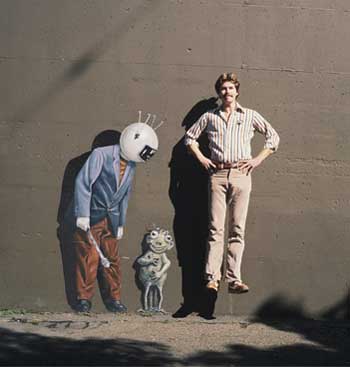

Muralist Greg Brown in recent years.

Brown working on the original burglar mural (now at 300 Hamilton) in the 1970s. (PAHA)
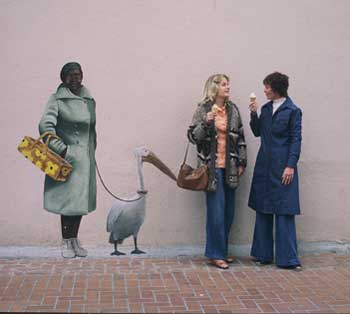
A pelican nips at a purse in a mural which no longer exists. (PAHA)
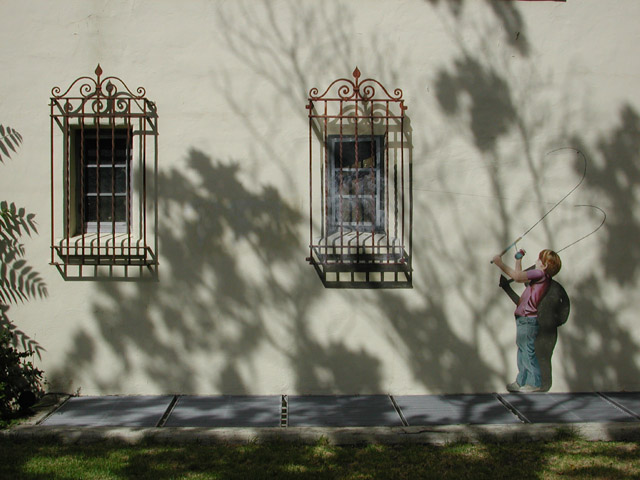
A boy goes for a catch on the side of the Palo Alto downtown post office.
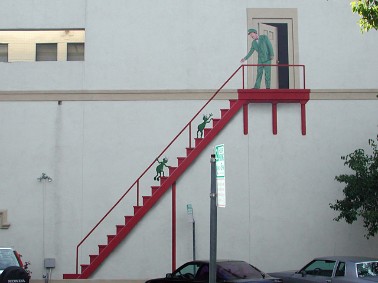
Aliens make their way to a milkman on the side of the Barker Hotel.
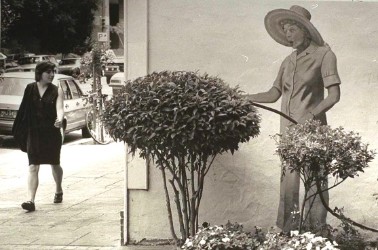
A woman makes a discovery on her garden hose on Waverley Street. (PAHA)
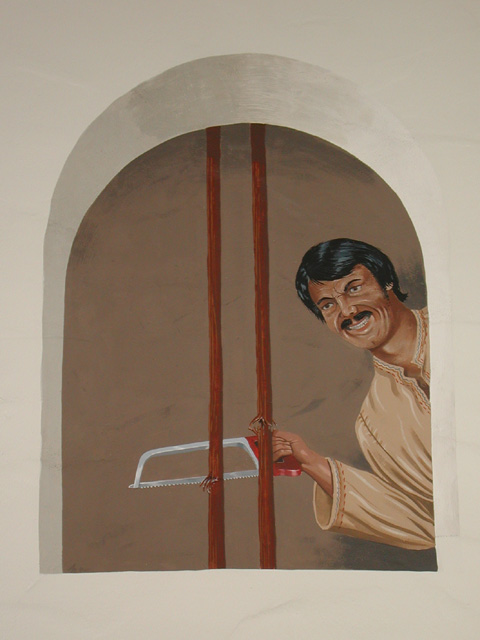
An evil-doer inside at 261 Hamilton.